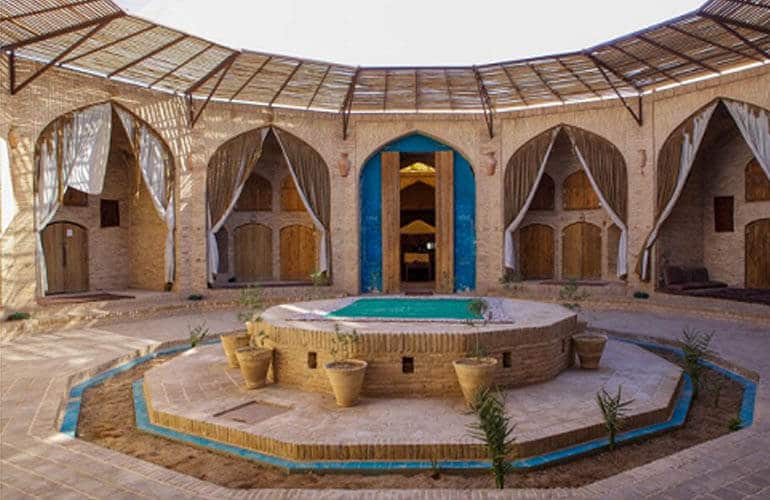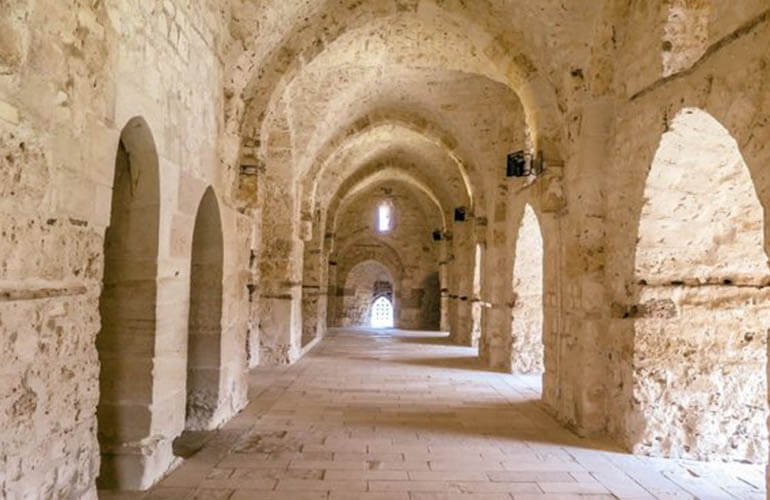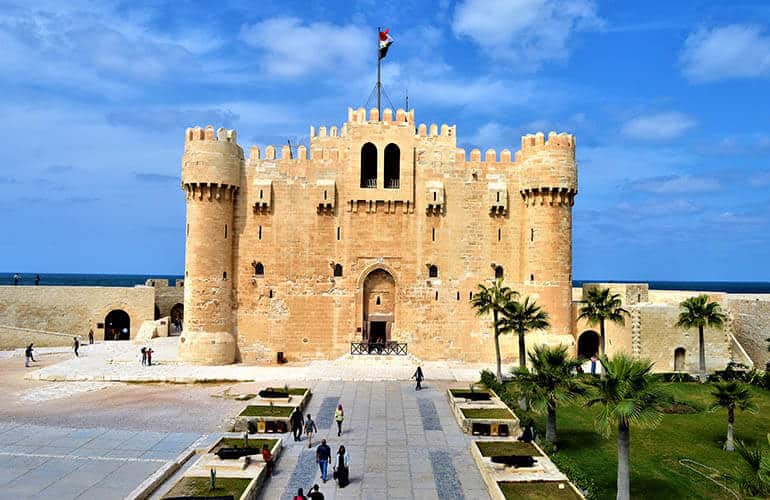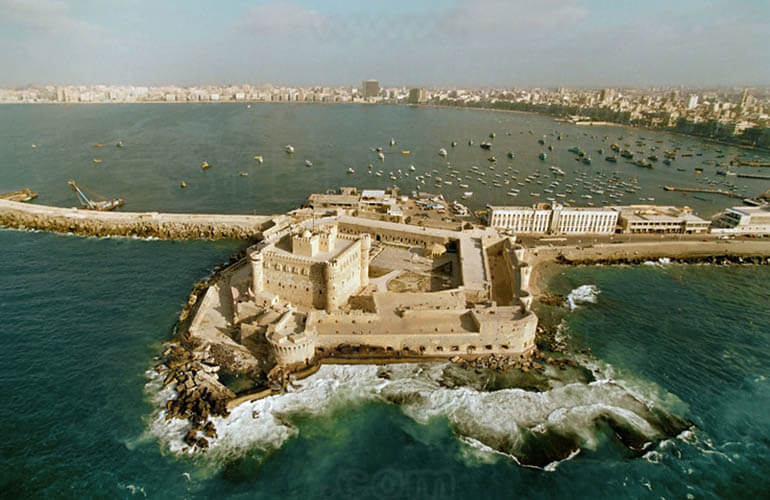Citadel of Qaitbay

Citadel of Qaitbay: Although the turreted Fort Qaitbey situated on the tip of the Eastern Harbour looks like some kind of toy castle from the corniche, up close it is an imposing building.
The fort was built in the 1480s by Sultan Qaitbey (1468-96) on the site of the Pharos Lighthouse, using stones from the dilapidated building. Within the keep, there is a small mosque – the oldest in Alexandria – and a Naval Museum displaying relics from ships sunk nearby, the result of Roman and Napoleonic sea battles.
These include bottles of wine and astronomical instruments retrieved from the French.
ship L’Orient. The fort was badly damaged by the British bombardment in 1882 when the mosque’s minaret was blown clean off. From its elevated position, set back from the corniche, the fort has fantastic views of Alexandria and out to sea.
The current shape of the castle is completely different from its original form, and this was the result of severe damage during the British bombing of Alexandria during a nationalist insurrection against British dominance in 1882 after that it’s rebuilt around the turn of the 20th century.
Qaitbay who built this castle, but all its efforts have been futile since the Ottomans conquered Egypt in 1512, and the castle remained Centered in a strategic location on a thin line of land stretching to the port of Alexandria to the Corniche
But it was far-sighted because the building itself did not important much, but the most important is the location itself, so Qaitbay built to benefit from the existence of an institution overlooking on the site—that of the legendary Pharos Lighthouse.
Who built the citadel of Aaitbay?

The founder of the Qaitbay fort was the Circassian sultan called Al Ashraf Abou Anasr Saif El-Din Quitbay El Jersaky AL Zahiry who ruled between 1468 and 1496. He was a Mamluk who came to Egypt young, less than twenty years old.
He was bought by Al-Ashraf Bersbay, so he remained in his service until he died and was acquired again by Sultan Djaqmaq, who granted him his freedom. Qaitbay then began to hold various positions, such as the head of the army during the rule of Sultan Tamar Budha.
When the sultan was dethroned, Qaitbay was appointed sultan in the year 1468. He was one of the most important and prominent Mamluk sultans, ruling for about 29 years. He was considered a brave ruler as he tried to start a new era with the Ottomans through the exchange of embassies and presents. He liked to travel and made considerable journeys.
Qaitbay liked art and architecture, so he created an important position among the administrative system of the state; that of a building architect. He built numerous charitable buildings in Mecca, Medina, and Jerusalem. There are about seventy buildings in Egypt that have been renovated thanks to his work, including mosques, madrasas, public fountains, houses, and military buildings such as the citadels of Alexandria and Rosetta. These citadels were built to protect northern Egypt, mainly from the Ottomans, whose power was growing in the Mediterranean.
The Citadel of Qaitbay throughout History

Qagmas Al-Eshaqy, the building architect, built the Citadel. Before his arrival in Egypt, he was a Mamluk from the area of Syria. During the rule of Qaitbay, he became an architect of buildings and later, a viceroy of Alexandria. He was also appointed governor of Syria, where he built a mosque in Damascus outside Rashid’s gate, as well as a Cenatofio and a caravanserai.
Thus, he renovated the mosque of El-Sawary on the outside of Sarah’s gate. Qagmas Al-Eshaqy was intelligent and modest, as well as a supervisor of many buildings during the Qaitbay era.
Ibn Ayas left in writing that Sultan Qaitbay traveled to Alexandria in 1504 accompanied by other Mamluk princes to visit the site of the ancient Lighthouse and during his visit, he ordered the construction of the Citadel.
The construction lasted two years and it is said that Qaitbay spent more than one hundred thousand dinars on its construction. The Sultan returned again to Alexandria when the construction was finished. He previewed the fort with a brave legion of soldiers and various weapons. He dedicated several habits with which he financed the works as well as the salary of the soldiers.
During the Mamluk period, and due to its strategic location, the Citadel of Qaitbay was well protected and cared for by the rulers who followed Qaitbay.
Sultan Qansuh Al-Ghouri paid special attention to the Citadel of Qaitbay. He visited it on several occasions and strengthened the garrison and its military equipment. He included a large prison built for the princes and statesmen he wanted to keep away.
When he felt an approaching Ottoman threat, he issued a military decree prohibiting the removal of weapons from the Citadel and even went so far as to issue the death penalty as punishment for those who tried to steal anything from the Citadel, even going so far as to inscribe a decree in marble above the gateway to the court.
The Citadel of Qaitbay during the conquest by the Ottoman

After the conquest by the Ottoman Turks of Egypt, even they protected the Citadel. They kept it in good condition and provided it with infantry, artillery, a company of drummers and trumpeters, as well as architects and carpenters.
Ottoman military power weakened And Lose the Importance of Citadel of Qaitbay
The citadel of Qaitbay in modern history

When Muhammad Ali Pasha became ruler of Egypt in 1805, he renovated the old fortress and repaired its outer walls, as well as providing the fort with the most modern weapons of the time, especially coastal guns. We can consider the reign of Mohammed Ali as another golden age for the Citadel.
The fortress managed to attract the interest of Mohammed Ali’s successors until 1882 when the Orabi Revolt took place. The British fleet bombarded Alexandria on July 11, 1882, and damaged much of the city, especially the area of the fortress, severely damaging the structure. The northern and western facades were badly damaged as a result of the explosions of the cannons, which were aimed directly at the fort. The west facade was completely destroyed, leaving huge openings in it.
How citadel of Qaitbay became a tourist attraction?

The Citadel of Qaitbay was then abandoned until 1904 when the Ministry of Defense restored the upper floors. King Faruq I wanted to turn the fortress into a royal resting place, so he sought a rapid renovation.
After the revolution of 1952, the Egyptian naval troops turned the building into a maritime museum. The major restoration dates back to 1984 when the Supreme Council of Antiquities drew up major plans for the refurbishment of the fort.
Book your Travel Package now to know more about Egypt’s history.






